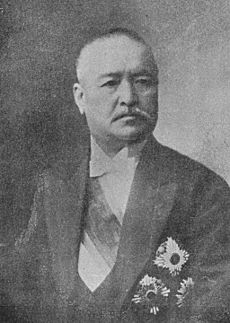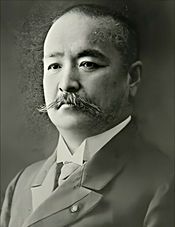Katsura Tarō facts for kids
Quick facts for kids
Prince
Katsura Tarō
|
|
|---|---|
|
桂 太郎
|
|
 |
|
| Lord Keeper of the Privy Seal of Japan | |
| In office 21 August 1912 – 21 December 1912 |
|
| Monarch | Taishō |
| Preceded by | Tokudaiji Sanetsune |
| Succeeded by | Prince Fushimi Sadanaru |
| Prime Minister of Japan | |
| In office 21 December 1912 – 20 February 1913 |
|
| Monarch | Taishō |
| Preceded by | Saionji Kinmochi |
| Succeeded by | Yamamoto Gonnohyōe |
| In office 14 July 1908 – 30 August 1911 |
|
| Monarch | Meiji |
| Preceded by | Saionji Kinmochi |
| Succeeded by | Saionji Kinmochi |
| In office 2 June 1901 – 7 January 1906 |
|
| Monarch | Meiji |
| Preceded by | Saionji Kinmochi (Acting) |
| Succeeded by | Saionji Kinmochi |
| Minister of War of the Japanese Empire | |
| In office 12 January 1898 – 23 December 1900 |
|
| Monarch | Meiji |
| Preceded by | Takashima Tomonosuke |
| Succeeded by | Kodama Gentarō |
| Governor General of Taiwan | |
| In office 2 June 1896 – 14 October 1896 |
|
| Monarch | Meiji |
| Preceded by | Kabayama Sukenori |
| Succeeded by | Nogi Maresuke |
| Personal details | |
| Born | 4 January 1848 Hagi, Nagato, Japan |
| Died | 10 October 1913 (aged 65) Tokyo, Japan |
| Cause of death | Stomach cancer |
| Resting place | Shōin Jinja, Setagaya, Tokyo |
| Political party | Constitutional Association of Allies (1913) |
| Other political affiliations |
Independent (1896–1913) |
| Profession | Soldier and politician |
| Awards | See Decorations |
| Signature |  |
| Military service | |
| Allegiance | Empire of Japan |
| Branch/service | Imperial Japanese Army |
| Rank | General |
| Commands | IJA 3rd Division |
| Battles/wars | Boshin War First Sino-Japanese War |
Prince Katsura Tarō (born January 4, 1848 – died October 10, 1913) was a very important Japanese politician and general. He served as the Prime Minister of Japan three times. This made him one of the longest-serving prime ministers in Japanese history.
Katsura was a skilled general who fought in the First Sino-Japanese War. He was also a genrō, which means he was an elder statesman who advised the emperor. Before becoming prime minister, he was the Governor-General of Taiwan and the Minister of War. He was known for being a conservative leader. His time as prime minister saw big changes in Japan, like the Russo-Japanese War and Japan taking control of Korea.
Contents
Early life and beginnings
Katsura Tarō was born on January 4, 1848, in Hagi, Japan. His family were samurai, who were like noble warriors. When he was young, he joined a movement against the old government, called the Tokugawa shogunate. He fought in battles during the Boshin War. This war led to the Meiji Restoration in 1868, which brought big changes to Japan.
Army career and military achievements
The new Japanese government saw that Katsura was very talented. In 1870, they sent him to Germany to study military science. He worked at the Japanese embassy in Germany as a military expert from 1875 to 1878 and again from 1884 to 1885. When he came back to Japan, he became a major general. He held important jobs in the Imperial Japanese Army, and in 1886, he became the Vice-Minister of War.
During the First Sino-Japanese War (1894–1895), Katsura led the IJA 3rd Division. His division made a difficult march in winter and helped capture important areas. After the war, he was given the title of viscount. He also served as the second Governor-General of Taiwan for a short time in 1896. From 1898 to 1901, he was the Minister of War.
Prime Minister of Japan
Katsura Tarō served as Japan's prime minister three times. He was the 11th, 13th, and 15th prime minister. For a long time, he was the longest-serving prime minister in Japan. However, Shinzo Abe later served for a longer total time.
First time as prime minister
Katsura first became prime minister on June 2, 1901. He stayed in office for four and a half years, until January 7, 1906. This was a record at the time. During this period, Japan became a powerful country in East Asia.
Important events during his first term included the Anglo-Japanese Alliance in 1902. This was an agreement with Britain. Japan also won the Russo-Japanese War against Russia from 1904 to 1905. Katsura also made an agreement with the United States, which recognized Japan's influence over Korea. For his achievements, he received honors from British King Edward VII and was given the title of marquess by Emperor Meiji.
Katsura was a very traditional politician. He believed his main duty was to the Emperor, not to political parties. He often disagreed with the Rikken Seiyūkai, the main political party in the lower house of the Japanese parliament. In January 1906, Katsura resigned. This happened after the Treaty of Portsmouth, which ended the war with Russia, became unpopular.
Second time as prime minister
Katsura became prime minister again from July 14, 1908, to August 30, 1911. During this second term, Japan officially took control of Korea in 1910. This was a very important event. He also introduced the Factory Act in 1911. This was the first law in Japan to protect workers.
However, people started to dislike Katsura more during his second term. They felt he was using his power to help himself and the military. They also didn't like that old-style politics, based on powerful families, continued. After he resigned, he became a prince and an important advisor to the emperor.
Third time as prime minister
Katsura was made prime minister for a third time on December 21, 1912. But this appointment caused big protests and riots. This period is known as the Taisho Political Crisis. Many people thought that powerful elder statesmen were trying to control the government too much.
Katsura tried to gain support by creating his own political party. It was called the Rikken Dōshikai. However, he faced a "no-confidence motion" in parliament. This was the first time such a motion succeeded in Japan. He lost the support of his allies and had to resign in February 1913. Yamamoto Gonnohyōe became the next prime minister.
Death
Katsura Tarō died eight months later, on October 10, 1913. He was 65 years old and passed away from stomach cancer. His funeral was held in Tokyo. He is buried at the Shōin shrine in Setagaya, Tokyo.
Honors and awards
Katsura Tarō received many honors and awards during his life. These included titles like Viscount, Count, Marquess, and Prince. He also received many important Japanese decorations, such as the Order of the Chrysanthemum. Foreign countries also honored him, including Russia, Germany, France, and the United Kingdom.
Images for kids
-
A bronze statue of Katsura Tarō on the top of the stairs of Takushoku University in Hachiōji, Tokyo
See also
 In Spanish: Katsura Tarō para niños
In Spanish: Katsura Tarō para niños








